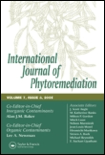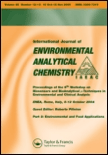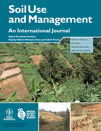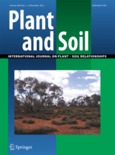
INTERNATIONAL JOURNAL OF PHYTOREMEDIATION
Scope & Guideline
Exploring Plant-Based Innovations in Environmental Recovery
Introduction
Aims and Scopes
- Phytoremediation Techniques and Technologies:
Research on various phytoremediation methods including the use of hyperaccumulators, constructed wetlands, and biofiltration systems to treat contaminated soils and water. - Mechanisms of Pollutant Uptake and Tolerance:
Studies investigating the physiological and biochemical mechanisms by which plants absorb and tolerate pollutants, including heavy metals and organic contaminants. - Microbial Interactions in Phytoremediation:
Research on the role of microbial communities associated with plant roots in enhancing phytoremediation efficiency and plant growth. - Innovative Materials and Amendments:
Exploration of novel materials such as biochar, nanoparticles, and organic amendments that can enhance the efficiency of phytoremediation. - Case Studies and Field Applications:
Documentation of successful phytoremediation projects in various environmental settings, providing practical insights into the application of research findings.
Trending and Emerging
- Integration of Biotechnology and Phytoremediation:
Recent publications are increasingly exploring biotechnological approaches, such as genetic modifications and the use of plant growth-promoting rhizobacteria (PGPR), to enhance phytoremediation effectiveness. - Focus on Microalgae and Aquatic Plants:
There is a growing interest in the use of microalgae and aquatic plants for phytoremediation, driven by their rapid growth rates and efficiency in nutrient and pollutant removal from wastewater. - Circular Economy and Waste Valorization:
Research is increasingly focusing on the dual benefits of phytoremediation and waste valorization, with studies examining how plant-based systems can recycle agricultural and industrial waste products. - Climate Change Resilience in Phytoremediation:
Emerging studies are looking at how plants can be used to remediate contaminated sites while also addressing climate change impacts, such as soil salinity and extreme weather conditions. - Nanotechnology in Phytoremediation:
The integration of nanomaterials in phytoremediation strategies is trending, with research focusing on how nanoparticles can improve pollutant uptake and detoxification processes.
Declining or Waning
- Traditional Soil Remediation Techniques:
There has been a noticeable reduction in publications focused solely on conventional soil remediation methods, such as soil washing or chemical treatments, as attention shifts towards more sustainable, plant-based approaches. - Limited Focus on Single Species Studies:
Research concentrating exclusively on single plant species for remediation is becoming less common, with a trend toward more complex systems involving multiple species or community interactions. - Decreased Emphasis on Laboratory-Only Studies:
There is a waning interest in studies that only assess phytoremediation in controlled laboratory settings, as researchers increasingly prioritize field studies and real-world applications.
Similar Journals

Biochar
Pioneering Sustainable Practices in Biomaterials and Soil ScienceWelcome to Biochar, an esteemed academic journal dedicated to the exploration and advancement of biochar technology and its applications across multiple fields. Published by SPRINGER SINGAPORE PTE LTD, this journal serves as a vital platform for disseminating high-quality research that addresses the critical intersection of environmental science, soil health, and sustainable materials development. With a commendable Q1 ranking in the fields of Biomaterials, Environmental Science, Pollution, and Soil Science, Biochar is recognized for its significant impact, as evidenced by its placement in the upper percentiles across various Scopus rankings. Researchers and professionals in agricultural and biological sciences will find valuable insights and innovative methodologies that promote sustainable practices and enhance soil quality. This journal, operating from its base in Germany, is committed to fostering a collaborative environment where cutting-edge research can inform policy and practice. Engage with us as we strive to advance the science of biochar from 2019 to 2024 and beyond.

Revista Internacional de Contaminacion Ambiental
Advancing Knowledge in Environmental ProtectionWelcome to the Revista Internacional de Contaminación Ambiental, a reputable journal dedicated to the field of environmental science, specifically focusing on pollution and waste management. Published by CENTRO CIENCIAS ATMOSFERA UNAM in Mexico, this journal has been a vital platform for scientific discourse since its inception in 1996 and continues to thrive as it converges into 2024. The journal holds a position in Quartile 4 for both Pollution and Waste Management in the 2023 rankings, as well as a Scopus rank in the environmental sciences category, reflecting its commitment to addressing urgent environmental issues. Although not an open-access publication, its meticulous contributions are crucial for researchers, professionals, and students alike, offering insights into pressing environmental challenges and innovative solutions. The Revista Internacional de Contaminación Ambiental is an essential resource for anyone engaged in the study and application of environmental protection and sustainable waste management.

Marine Pollution Bulletin
Unraveling the impacts of human activity on marine life.Marine Pollution Bulletin is a premier interdisciplinary journal dedicated to publishing innovative research and critical reviews focused on the impact of human activities on marine ecosystems. Published by PERGAMON-ELSEVIER SCIENCE LTD, this journal is renowned for its rigorous peer-review process and holds a prestigious position in the academic community, with a 2023 Q1 ranking in Aquatic Science, Oceanography, and Pollution. With a history spanning from 1970 to 2024, it provides a vital platform for researchers, professionals, and students alike to share groundbreaking findings in marine environmental science. The journal, based in the United Kingdom at The Boulevard, Langford Lane, Kidlington, Oxford OX5 1GB, England, is indexed in Scopus and ranks impressively in various categories, underscoring its significance in advancing the understanding of marine pollutants and their ecological consequences. Submissions are encouraged for original research, review articles, and case studies that contribute to this critical field, enabling the academic community to explore solutions for mitigating marine pollution.

Soil Ecology Letters
Exploring the Vital Role of Soil in Global HealthSoil Ecology Letters, published by SpringerNature, is a premier journal dedicated to advancing the knowledge and understanding of soil ecosystems, their functions, and their vital role in global sustainability. Since its inception in 2019, this leading journal has consistently maintained its prestigious Q1 ranking in Ecology, Evolution, Behavior and Systematics, as well as Soil Science, reflecting its significant impact in the ecological and environmental sciences community. With an impressive Scopus ranking that places it within the top percentile of journals in its field, Soil Ecology Letters provides a platform for researchers and professionals to disseminate their groundbreaking findings. The journal is a vital resource for advancing research in agricultural and biological sciences, offering open access options that promote widespread dissemination of knowledge. With its focus on fostering collaboration and innovation in soil ecology, this journal is essential reading for anyone aiming to deepen their understanding of soil environments and their critical role in ecological health.

Atmospheric Pollution Research
Pioneering research for a pollution-free future.Atmospheric Pollution Research is a pivotal journal within the realms of Atmospheric Science and Environmental Science, published by the Turkish National Committee on Air Pollution Research and Control (TUNCAP). With an impressive impact, it holds a Q2 ranking in Atmospheric Science and Waste Management and Disposal, and a Q1 ranking in Pollution as of 2023, underscoring its significance and influence in the field. The journal's ISSN 1309-1042 facilitates the dissemination of cutting-edge research addressing contemporary issues in air quality and pollution management. Spanning a convergence of years from 2010 to 2024, it publishes original articles, reviews, and case studies that are essential for advancing knowledge in air pollution and its environmental impacts. Researchers, professionals, and students worldwide will find this journal to be an invaluable resource for staying updated on the latest findings and innovations aimed at mitigating the effects of atmospheric pollution.

Pollution
Transforming environmental science through impactful research.Pollution is a distinguished open-access journal published by UNIV TEHRAN, dedicated to advancing the understanding of environmental science and the multifaceted aspects of pollution research. Since its establishment in 2015, the journal has been committed to disseminating high-quality, peer-reviewed articles that address the pressing issues of environmental degradation globally. With an impact factor and a Scopus rank that places it within the top tier of Environmental Science (Rank #141/233), Pollution serves as an essential resource for researchers, professionals, and students alike. The journal encompasses a wide range of topics, including the sources, effects, and mitigation strategies related to various forms of pollution, thereby aiming to contribute significantly to the scientific community's efforts in promoting environmental sustainability. Its innovative and timely approach positions Pollution as a vital platform for sharing knowledge and fostering interdisciplinary collaboration in the environmental science domain.

Journal of Environmental Health Science and Engineering
Connecting academia and practice in environmental health science.Journal of Environmental Health Science and Engineering, published by Springer, stands at the forefront of scholarly research in environmental health and engineering. With an impressive E-ISSN of 2052-336X and a significant impact factor reflected in its Q2 quartile rankings across various essential categories—including Applied Microbiology, Environmental Engineering, and Public Health—the journal serves as a vital platform for disseminating high-quality research from 2012 to 2024. Its rankings in fields such as Environmental Science and Waste Management position it as a distinguished resource for professionals and academics aiming to advance their understanding of contemporary environmental challenges. As an open-access journal based in Switzerland, it champions accessibility and collaboration, allowing researchers to share insights that influence policy and practical applications in environmental health. The journal's commitment to fostering innovative research makes it indispensable for those dedicated to enhancing the intersection of environmental science and public health.

INTERNATIONAL JOURNAL OF ENVIRONMENTAL ANALYTICAL CHEMISTRY
Illuminating the path to cleaner, healthier ecosystems.INTERNATIONAL JOURNAL OF ENVIRONMENTAL ANALYTICAL CHEMISTRY, published by Taylor & Francis Ltd, stands as an essential resource in the interdisciplinary field of environmental science and analytical chemistry. With a history dating back to 1971 and a convergence period extending to 2024, this journal addresses urgent global challenges by providing a platform for high-quality research that encompasses pivotal aspects of environmental analysis, pollution, and public health. The journal’s significant impact is reflected in its 2023 rankings, placing it in the second and third quartiles across various relevant categories, including Analytical Chemistry, Environmental Chemistry, and Water Science and Technology. Researchers and practitioners are encouraged to contribute to its wealth of knowledge, making it a vital reference for emerging studies in Health, Toxicology and Mutagenesis and beyond. Although it is not an open-access journal, subscriptions provide unparalleled access to groundbreaking research that can influence both academia and industry practices.

SOIL USE AND MANAGEMENT
Connecting research to practice in soil management.SOIL USE AND MANAGEMENT is a premier academic journal published by Wiley, focusing on the critical domains of Agronomy, Crop Science, Pollution, and Soil Science. With an ISSN of 0266-0032 and an E-ISSN of 1475-2743, the journal has established itself as a vital resource in the field since its inception in 1985. Operating from its U.S. headquarters in Hoboken, NJ, SOIL USE AND MANAGEMENT boasts impressive Q1 rankings across its relevant categories, indicating its standing in the top tier of research journals. Notably, it is ranked 48th out of 406 journals in Agronomy and Crop Science and holds an 88th percentile position, as well as a commendable rank of 26th out of 159 journals in Soil Science, underscoring its influence and reach. This journal serves as an essential platform for researchers, professionals, and students dedicated to sustainable soil management practices and understanding soil's role in agricultural productivity and environmental health. Although it does not offer Open Access, its rigorous peer-review process ensures the publication of high-quality original research, reviews, and case studies critical for advancing knowledge and practice in the field. This journal is crucial for anyone engaged in soil science and its related disciplines, encouraging innovative approaches to challenges facing soil use and management today.

PLANT AND SOIL
Innovating research to enhance crop productivity and ecosystem balance.PLANT AND SOIL is a prestigious academic journal that has been at the forefront of plant and soil research since its inception in 1948. Published by SPRINGER in the Netherlands, this journal has carved a niche as a leading source of high-quality, peer-reviewed articles, which are essential for researchers, professionals, and students in the fields of Plant Science and Soil Science. With an impressive impact factor placing it in the Q1 category of both disciplines, it ranks 50th in the field of Plant Science and 24th in Soil Science, highlighting its influence in the scientific community. Although not available as open access, the journal provides a wealth of knowledge and insights into the interactions between plants and soils, exploring critical topics such as soil health, crop productivity, and sustainable agriculture practices. Researchers who wish to contribute to this vital area of study through their empirical findings will find PLANT AND SOIL to be an invaluable platform for disseminating their work and connecting with a network of leading scholars committed to advancing our understanding of these essential ecosystems.